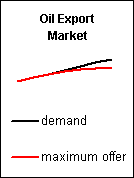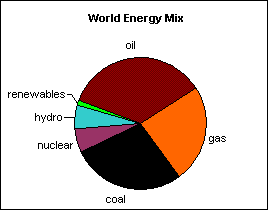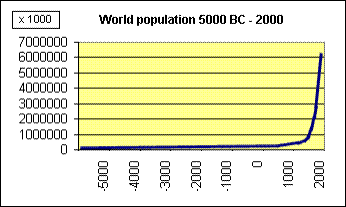|
FRIDAY EDITION December 19th, 2025 |
|
Home :: Archives :: Contact |
 |
Energy crisis: Turning-point of humanityRudo de Ruijter,Independent researcher rudoderuijter@wanadoo.nl Jine 25th, 2008 After more than 150 years of increasing availability of energy and an explosive growth of the world population, we are now entering an era of always decreasing availability of energy. The world population will shrink. For this new era new economic principles are needed to maintain prosperity. Part of this is a bank-reform, that members of Parliament can compel if they want.  The oil-price rises explosivily. This time it is not about some action of OPEC, a threat of war or a cold winter. Today's rises in price are the result of a turning-point in the oil supply. Demand keeps growing and the oil extraction has reached its ceiling. And, as the oil exporting countries use more and more oil themselves, less oil is offered on the export-markets. Those who count on alternative energy sources are wrong. Gas, coal, nuclear, hydro, wind and solar energy cannot make up the shortage of oil. The world population will have to do with less energy.  Today's mix of energy use consists of 36 percent oil, 24 percent gas, 28 percent coal, 6 percent nuclear, 6 percent hydro-power and 1 percent renewables, like wind and solar energy. The Canadian researcher Paul Chefurka has made an analysis and a prognosis of each energy source. See the pictures left and beneath. For explanation and details, please read his article World Energy and Population [1] http://www.courtfool.info/en_World_Energy_and_Population.htm
Most big oil fields in the world are "empty" now or slowing down. (Peak-oil.) For the extraction from the remaining smaller fields a lot more investments are needed and the extraction speed is lower. The lowering capacity can only partly be compensated by other sources of energy. The peak in gas extraction is expected within a relative short time. The richest coal (anthracite) is depleted for the most part. The remaining coal is poorer in energy and demands higher extraction cost. Coal has a high CO2 emanation, and solutions to this problem are still in an experimental stage. The capacity of existing and planned nuclear plants is far to small to compensate the fall in energy. A rapid making-up of arrears cannot be expected with nuclear plants. For hydro-energy the interesting locations are already in use and, here too, a multiplication of capacity cannot be expected. Renewable energy, like wind and solar, hardly represent anything compared with global energy consumption. In spite of hopeful developments, its share will remain insignificant for still a long time.[1] World population  The explosive growth of the world population has been possible by the one-time consumption of fossil energy. We now have reached the top of the energy-extraction. The extraction of the remainder demands more cost and efforts for a lower output. The lowering availability of energy will logically lead to a shrinking world population. Big differences per country The world population consumes in average 1.8 TOE (Tons of Oil Equivalence) per person per year. The use of energy in the world varies a lot. The 2.8 billion people in China, India, Pakistan and Bangladesh consume 0.8 TOE per person per year. In the US this is 8 TOE per person per year. If we take a look at the dependency on energy-import, we notice that, calculated per inhabitant, Western European countries, Japan and the United States import more than 2 TOE per year (numbers from 2005).
When there are shortages on the energy export-markets, those countries are in trouble first. In this situation the US has the advantage that most energy is still traded in dollars. Financially they can dispose of it freely (by inflation and growth of the external debt) [3] The role of the other energy-importing countries is double. On the one hand their demand for dollars helps to keep the dollar rate upright (and with the dollar rate, the US-imperium). On the other hand, most often they are also military allies of the US, who likewise profit of the submission of Iraq [3] and the occupation of Afghanistan. [4] Oil applications Today's oil crisis makes it painfully clear, that various forms of energy cannot be exchanged easily. Oil is made into diesel oil and fuel (70 percent), petrol/gasoline (13 percent), bitumen, lubricating oil, kerosene, butane, liquid petrol gas, naphtha, benzene and toluene. From these, naphtha, benzene and toluene are the raw materials for chemicals, plastics, synthetic fibers and rubbers. Chemicals are in cleaning products, medicins, anti-freeze, paints, insecticides, fertilizers, soap and explosives. Plastics are used in bags, beer-cases, suit-cases, dustbins, dashboards, pipes, gutters, tubes, floor-coverings and polystyrene. Synthetic fibers and rubbers are made into textiles, silicons and tyres. [5] All those products have their places in our daily life and most of them cannot simply be exchanged by others. Transport and cohesion Everywhere in the world the massive availability of diesel and petrol has determined the organization and cohesion of societies. Distances to be covered, considered normal unto now, will become very expensive, particularly in food-supply, commuting, trade and industry. In social life too, short distances will become more and more important. Food and energy The modern high-output food production swallows a lot of energy. In the US the production of 1 unit of energy in food demands 1.56 unit of fossil energy. When we also take into account transportation, processing, packaging, distribution, conservation and cooking, 1 unit of energy in food demands not less than 7.36 units of fossil energy. [6] The biggest threat for the intensive agriculture in 2008 is the doubling of the price of fertilizers, as a result of the oil-crisis. [7] Products of high-output agriculture will become too expensive for a large part of the world population. The biggest economy in energy can be made with traditionally produced food from farmers in the neighbourhood. Continuing is war With the present size of the world population it is quite certain, that there will not be enough food and energy in the coming 75 years. If the world population does not shrink radically and the strive for economic growth is not banned, more and more of our children will be sent to war to get more food and energy. (Of course these wars will be camouflaged as peace-keeping operations, development aid, democratisations and anything else the leaders of industrialized countries come up with to avoid the nasty taste of murder and robbery to their people.) Growth-model The always increasing availability of energy did not only allow an explosive growth of the population, but also came with economic models that function according to the principal of endless economic growth. They assume an always increasing availability of raw materials, energy, working force and consumers. These models dominate the thinking of politics and economy in most countries of the world. The motor in these models is the money-system, that, by a permanent inflation, forces to more and more activity to forestall impoverishment. [2] Although the decrease in available energy has already started on the export markets, we still don't have solutions for our economy - except warfare. For the moment there is a lack of consciousness, knowledge and comprehension. Slimming-model During our lifetime we never knew anything else but the growth model. That is in use nearly everywhere in the world. That is why we do not realize sufficiently, it is just an economic model. It only applies in a situation of permanent increase of energy, raw materials, working force and consumers. When the economy must function with a shrinking availability of energy, we need another economic model. In the slimming model there is a shrinking production and a shrinking consumption, caused by the decrease of energy. When there is less energy available than needed for a big population, we should - logically - strive for a smaller population. If we start the decrease in population early enough, then, counted per inhabitant, prosperity can be maintained at a high level. (When the population is too big, it will be war and economic crisis.) Bank-reform In today's system new money is created by commercial banks each time loans are made. For all commercial banks together, there is not a single limit in the unbridled money-creation. It can, at best, be stimulated or slowed down a bit by the interest rate of the central bank. Central banks themselves profit from inflation and changing interest rates, which allow them income from monetary operations, that garantee their independence. [2] This system of permanent inflation should be replaced. The money creation should be limited to the central bank. Today's banks would become middlemen, who hand the loans to their customers. For these customers nothing changes. Their bank accounts continue in the same way.
By removing the permission to create money from the commercial banks and put this right exclusively in the hands of the central bank, the latter can immediately stop the inflation. Consequently the central bank doses carefully the amount of money in circulation, in order to prevent any devaluation of the money unit. In accordance with the government, different interest rates can be used for different categories of loans. This way, for instance, long term investments for a sustainable society can be financed prioritarily, or, the other way around, unwanted investments can be discouraged. In this way a slimming model in a situation of decreasing population can provide maintenance of prosperity. Note, that in countries where there is still an increasing availability of energy, the bank-reform lined out above offers a better structure for sustained prosperity too. By the differentiation of interest rates, long term investments for a sustainable future can be financed and, also, investments can be stimulated or discouraged by sector. Further more the excesses in money creation can be stopped immediately and prevented in the future. There is no obligation to apply this reform in several or all countries at the same time. Probably, in many countries, the central bank has enough legal power to implement such a reform independently. In other countries some changes will have to be made in the laws. Members of Parliament During the last century some central banks have built a questionable reputation as regulator of the economy. And some central banks are still haunted by the neo-conservative ideas of Friedman. That is why it is not sure at all. that all central banks are inclined to such kind of reform. In most countries their power is based on just a few articles of law. These articles qualify their authority. When governments want, they can withdraw these articles and put the creation of money in the hands of the state. (Opponents will say, the governments will make a mess of it. I think, that the financial crisis has sufficiently proven, that it is the commercial banks, who are making a mess of it.) Rudo de Ruijter,Independent researcher rudoderuijter@wanadoo.nl Jine 25th, 2008 [1] Paul Chefurka, World Energy and Population http://www.courtfool.info/nl_Wereldbevolking_en_energie.htm http://www.paulchefurka.ca/WEAP/WEAP.html [2] Secrets of money, interest and inflation http://www.courtfool.info/en_Secrets_of_Money_Interest_and_Inflation.htm [3] Cost, abuse and danger of the dollar http://www.courtfool.info/en_Cost_abuse_and_danger_of_the_dollar.htm [4] Pipelines to 9/11 http://www.courtfool.info/en_Pipelines%20to%209_11.htm [5] Oil-products http://proto4.thinkquest.nl/~lld581/index.php?id=14 [6] Fact sheets US Food System http://css.snre.umich.edu/css_doc/CSS01-06.pdf [7] New threat to food system: pricey fertilizer http://www.reuters.com/article/homepageCrisis/idUSN20324889._CH_.2400 |
| Home :: Archives :: Contact |
FRIDAY EDITION December 19th, 2025 © 2025 321energy.com |
|